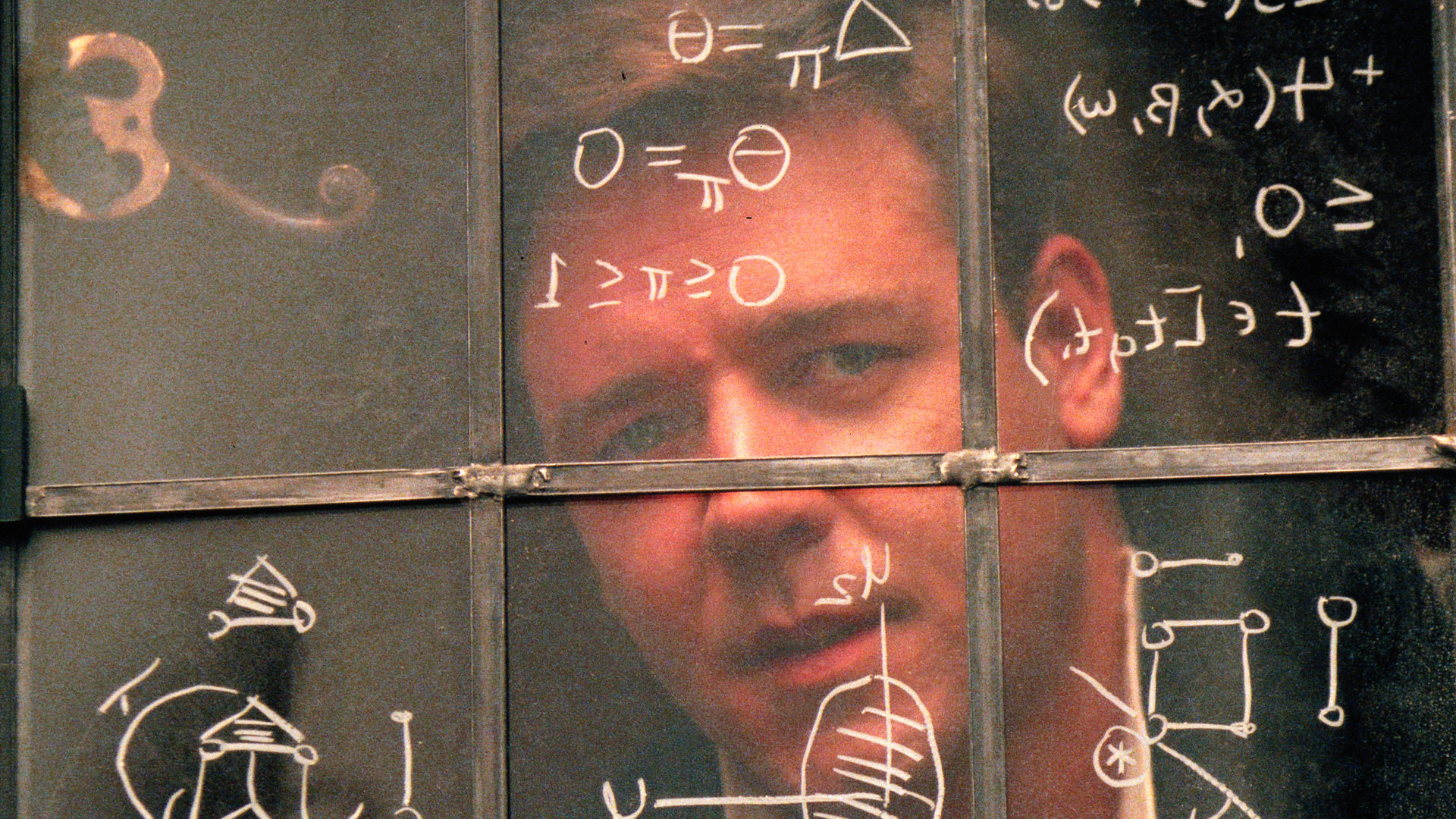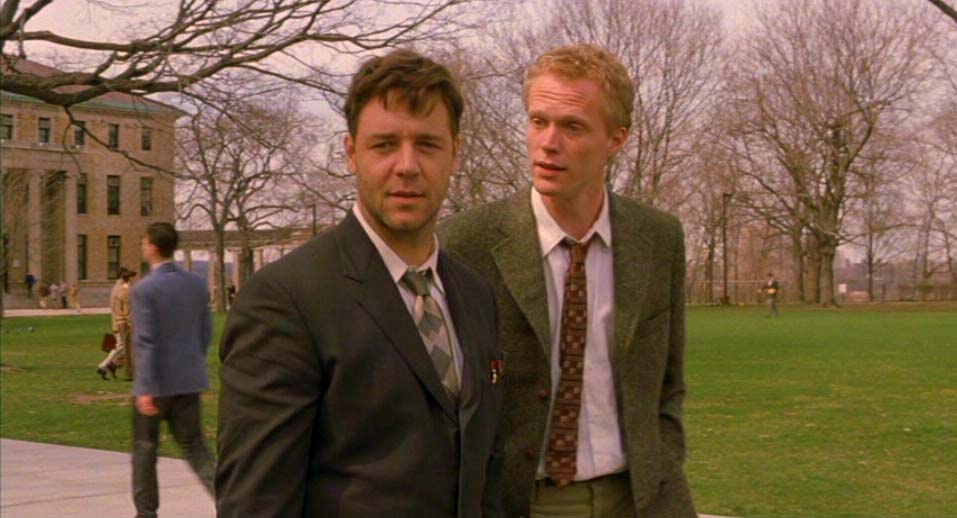Movie Depiction of Schizophrenia Symptoms

Source: amblin.com
“A Beautiful Mind,” while a compelling narrative, presents a somewhat romanticized and ultimately inaccurate portrayal of schizophrenia. While it raises awareness, the film’s depiction simplifies the complex reality of the illness, potentially leading to misconceptions among viewers. The movie focuses heavily on the positive symptoms, particularly hallucinations, while largely neglecting the debilitating negative symptoms that often significantly impact the lives of individuals with schizophrenia.
The film showcases John Nash’s experience with schizophrenia through vivid hallucinations, primarily involving his imagined roommate, Charles, and two other individuals who appear to be government agents. These hallucinations, presented as fully realized characters interacting with Nash, are a prominent example of positive symptoms. Scenes depicting Nash engaging in elaborate conversations with these individuals, believing them to be real, are powerful visual representations of his delusional thinking. Conversely, negative symptoms, such as avolition (lack of motivation), alogia (poverty of speech), and anhedonia (inability to experience pleasure), are less explicitly depicted. While Nash’s withdrawal and periods of isolation are hinted at, the film does not fully capture the profound impact of these symptoms on daily functioning.
Hallucinations in “A Beautiful Mind” versus Lived Experience
The film’s portrayal of hallucinations is dramatic and visually striking. Nash’s hallucinations are often presented as coherent and interactive, even engaging in complex plots and conversations. This contrasts sharply with the lived experience of many individuals with schizophrenia, where hallucinations can be fragmented, disturbing, and frightening. They may involve auditory hallucinations (hearing voices), visual hallucinations (seeing things that aren’t there), or other sensory disturbances, and are often less organized and more distressing than depicted in the film. The movie’s depiction, while dramatic, simplifies the chaotic and often terrifying nature of these experiences for many individuals. The film’s focus on the relatively “organized” hallucinations of its protagonist might lead viewers to underestimate the range and severity of hallucinatory experiences in schizophrenia.
Impact on Public Perception
“A Beautiful Mind’s” portrayal of schizophrenia, while raising awareness, risks shaping public perception in potentially harmful ways. By focusing primarily on the positive symptoms and a relatively successful recovery narrative, the film might inadvertently downplay the chronic and debilitating nature of the illness for many individuals. The film’s narrative arc, culminating in Nash’s apparent management of his illness, might create a false sense of optimism or easily attainable recovery. This could lead to unrealistic expectations about treatment outcomes and hinder efforts to destigmatize the illness by suggesting that it is simply a matter of willpower or a “gift” rather than a serious mental health condition requiring ongoing care and support. The film’s impact highlights the importance of balanced and accurate portrayals of mental illness in media to foster a more nuanced and compassionate understanding of the challenges faced by individuals living with schizophrenia.
John Nash’s Experience and the Disease
A Beautiful Mind offers a compelling, albeit dramatized, portrayal of John Nash’s life with schizophrenia. The film depicts not only the brilliance of his mind but also the devastating impact of his illness, illustrating the complex interplay between his genius and his mental health struggles. The progression of his illness, as shown, is a gradual descent into paranoia and delusion, punctuated by periods of relative lucidity and intense suffering.
The film showcases a range of schizophrenic symptoms throughout Nash’s life. Initially, subtle signs appear: a growing sense of isolation, unusual fixations, and increasingly erratic behavior. These early manifestations are difficult to discern from the eccentricities often associated with genius, blurring the lines between creative eccentricity and the onset of illness. The viewer witnesses a slow but steady deterioration as his hallucinations become more vivid and intrusive, influencing his perceptions of reality.
Progression of John Nash’s Schizophrenia
The film depicts Nash’s illness as a chronic, relapsing condition. Early symptoms are subtle, possibly misattributed to his intense focus on his work. However, his hallucinations, initially appearing as a shadowy figure, become more defined, involving a fellow mathematician and later, his imagined son. These hallucinations are consistently interwoven with his reality, affecting his judgment and decision-making. His delusions of grandeur and paranoia escalate, particularly evident in his distrust of the NSA and his belief in his own importance to national security. The movie shows periods of remission, where he seemingly regains control, interspersed with acute episodes of psychosis, characterized by heightened paranoia and disorientation. These fluctuations highlight the unpredictable nature of the disease.
Specific Symptoms Displayed in the Film
The film vividly portrays several key symptoms of schizophrenia. Hallucinations are central to the narrative, with Nash consistently seeing and interacting with his imaginary roommate, Charles, and later, his imaginary son. These hallucinations aren’t fleeting; they are persistent and deeply embedded in his reality. Delusions, particularly delusions of grandeur and paranoia, are also prominent. He believes he’s been chosen for a clandestine mission, convinced that he is decoding secret messages and that the NSA is after him. Disorganized thinking and speech are less overtly displayed but are implied through his erratic behavior and difficulty maintaining coherent conversations during acute episodes. His social withdrawal and emotional flatness are also evident, particularly in his strained relationships.
Impact on Relationships and Professional Life
Nash’s schizophrenia profoundly impacts his relationships. His wife, Alicia, endures years of emotional turmoil, struggling to understand and support him through his illness. His paranoia and delusions damage his trust in others, leading to isolation and strained professional relationships. His academic career suffers, as his hallucinations and delusions interfere with his research and ability to collaborate effectively. The film subtly highlights the toll his illness takes on his professional life, showing periods of productivity interspersed with long stretches of inactivity and instability. His struggles with maintaining professional connections are a constant undercurrent in the narrative.
Challenges of Diagnosis and Treatment
The film doesn’t explicitly detail the diagnostic process, but it implicitly highlights the challenges. The initial subtle symptoms are easily overlooked, particularly in a highly intelligent individual like Nash. His erratic behavior could be misinterpreted as eccentricity, delaying proper diagnosis and intervention. The film shows the difficulties of treatment, illustrating the trial-and-error nature of finding the right medication and therapy. Nash’s reluctance to accept his illness and his resistance to treatment further complicate the process, emphasizing the struggle for both patient and caregiver in managing schizophrenia. The film suggests the long and arduous path toward managing the illness, and the importance of consistent support and acceptance.
Impact of Medication and Treatment

Source: intofilm.org
A Beautiful Mind’s portrayal of John Nash’s treatment for schizophrenia offers a glimpse into the challenges and complexities of managing this severe mental illness. The film depicts a journey marked by periods of effective treatment interspersed with relapses, highlighting the ongoing nature of the disease and the limitations of available therapies, especially during the time period depicted.
The film shows Nash initially resistant to medication and therapy, reflecting the common stigma and reluctance associated with mental health treatment. His eventual acceptance of medication is presented as a turning point, albeit one achieved with considerable struggle and a degree of coercion from his wife Alicia. The movie visually represents the positive impact of treatment through scenes of increased clarity and improved functionality in Nash’s life. However, it also depicts the negative side effects, including the emotional blunting and other disruptions to his personality, suggesting a delicate balance between managing symptoms and preserving quality of life.
Medication’s Depiction and Effectiveness
The film doesn’t explicitly name the medications used, but it portrays their effectiveness in managing Nash’s hallucinations and delusions. The visual representation of these improvements, such as the reduction in his paranoia and the gradual return to his academic pursuits, suggests a positive response to treatment. However, the film also underscores the fact that medication alone is not a complete solution; it’s presented as a crucial component of a broader treatment strategy, requiring consistent adherence and ongoing monitoring. The film’s depiction aligns with the reality that antipsychotic medications are highly effective in reducing the positive symptoms of schizophrenia (hallucinations and delusions), but may not fully address negative symptoms (flat affect, social withdrawal) or cognitive impairments.
Comparison with Current Medical Approaches
While the film’s depiction of treatment is somewhat dated, reflecting the medical understanding of schizophrenia in the mid-20th century, several aspects remain relevant. The emphasis on medication as a cornerstone of treatment is consistent with current medical practice. Today, antipsychotic medications, both typical and atypical, form the backbone of schizophrenia treatment. However, modern approaches place greater emphasis on a combination of pharmacological and psychosocial interventions. Cognitive behavioral therapy (CBT), family therapy, and social skills training are now widely integrated into treatment plans to address the broader spectrum of symptoms and improve overall functioning. The film’s depiction lacks the nuance of these additional therapies, which are now considered essential components of effective long-term management.
Side Effects and Treatment Challenges
The movie showcases the potential side effects of antipsychotic medications through scenes illustrating emotional blunting and a dampening of Nash’s personality. This reflects the reality that many antipsychotics can cause significant side effects, including weight gain, movement disorders (tardive dyskinesia), and metabolic changes. The film subtly conveys the difficulty of finding the right balance between symptom control and minimizing side effects, a constant challenge for clinicians and patients alike. Furthermore, the film highlights the challenges of medication adherence, with Nash’s initial resistance and later struggles underscoring the importance of patient engagement and support systems in successful treatment. The film does not, however, portray the more severe side effects that can be associated with some antipsychotic medications, nor the availability of newer medications that carry a reduced risk of some of these effects.
Social and Interpersonal Effects of Schizophrenia

Source: quotesgram.com
A Beautiful Mind poignantly portrays the devastating impact of schizophrenia on John Nash’s social and interpersonal life, highlighting the profound isolation and stigma associated with the illness. The film doesn’t shy away from depicting the challenges of maintaining relationships while battling the debilitating effects of the disease, offering a glimpse into the strain placed on both Nash and those closest to him.
Social Isolation and Stigma
The film vividly illustrates John Nash’s increasing social isolation as his schizophrenia progresses. His delusions and hallucinations drive a wedge between him and his colleagues, friends, and family. The stigma surrounding mental illness further exacerbates his isolation, leading to misunderstanding and rejection.
| Scene | Interaction | Outcome | Impact on John |
|---|---|---|---|
| Early career at MIT | Attempts to collaborate with colleagues on research | Increasingly erratic behavior leads to strained relationships and professional setbacks. | Growing sense of alienation and paranoia. |
| Marriage to Alicia | Initial passionate relationship, later strained by John’s illness. | Alicia struggles to cope with John’s unpredictable behavior and delusions, leading to periods of separation. | Increased feelings of loneliness and distrust. |
| Hospitalization | Interaction with fellow patients and medical staff | Experiences further social isolation and stigmatization. | Deepened sense of otherness and hopelessness. |
| Later life | Reconciliation with Alicia and gradual reintegration into society | Limited but meaningful social interactions are possible with medication and support. | Improved social functioning, but lingering effects of isolation and stigma remain. |
Strain on Personal Relationships
The film powerfully demonstrates the immense strain schizophrenia places on Nash’s relationship with his wife, Alicia. Alicia’s unwavering dedication to John is juxtaposed with the immense challenges she faces in supporting him through his illness. Her struggles to balance her own needs with the demands of caring for a spouse with schizophrenia are central to the narrative. The film shows how the illness tests the limits of their love and commitment, resulting in periods of separation and intense emotional turmoil. The constant fear, uncertainty, and unpredictable behavior from John take a significant toll on Alicia’s emotional and mental well-being. The film subtly portrays the emotional exhaustion and sacrifice involved in maintaining a relationship with someone suffering from schizophrenia.
Challenges of Maintaining Social Connections
Maintaining social connections while battling schizophrenia proves exceptionally difficult for John. His delusions and hallucinations often interfere with his ability to engage in meaningful social interactions. He becomes increasingly suspicious and distrustful of others, making it challenging to form or maintain relationships. His erratic behavior and unpredictable outbursts further alienate him from his peers and colleagues. The film highlights the constant struggle to navigate social situations while grappling with the intrusive symptoms of his illness. The gradual improvement in his social functioning after beginning treatment underscores the importance of medication and therapy in managing the illness and fostering healthier social interactions.
Impact on Family and Colleagues
Schizophrenia’s impact extends beyond John himself, profoundly affecting his family and colleagues. The film depicts the emotional toll on Alicia, who endures years of uncertainty, fear, and emotional strain. Her unwavering love and support, despite the immense challenges, serve as a testament to the resilience of family members caring for loved ones with mental illness. John’s colleagues, initially supportive, gradually become distanced as his behavior becomes increasingly erratic and unpredictable. Their reactions reflect the common societal misunderstanding and stigma surrounding mental illness. The film subtly portrays the burden placed on those surrounding John, highlighting the systemic and interpersonal challenges associated with supporting someone with schizophrenia.
Artistic License and Accuracy: A Beautiful Mind Movie Schizophrenia Symptoms
“A Beautiful Mind” offers a compelling narrative, but its portrayal of schizophrenia necessitates a careful examination of artistic liberties taken for dramatic effect and their contrast with the reality of the illness. The film’s success in raising awareness about mental illness is undeniable, yet the specific depiction of John Nash’s experiences requires nuanced consideration regarding its accuracy and potential impact on public understanding.
The film dramatically condenses Nash’s life and illness, streamlining a complex timeline and experience into a more digestible narrative. For instance, the film heavily emphasizes Nash’s hallucinations and paranoid delusions, presenting them as the primary symptoms and often overshadowing other common aspects of schizophrenia, such as negative symptoms like avolition (lack of motivation) or alogia (poverty of speech). While hallucinations and delusions are indeed significant symptoms, the film’s focus creates a somewhat skewed perspective, implying that these are the defining characteristics of the disorder for all sufferers. This simplification risks reinforcing harmful stereotypes about schizophrenia and its sufferers.
Discrepancies Between Film and Factual Information
The film portrays Nash’s recovery as primarily driven by his own willpower and intellectual strength, minimizing the crucial role of medication and ongoing therapy. While self-reliance and cognitive resilience can be helpful in managing the illness, schizophrenia is a chronic illness requiring consistent medical intervention for effective management. This omission potentially diminishes the importance of seeking professional help and adhering to prescribed treatment plans. The film also depicts Nash’s interactions with his imagined colleagues and their influence on his mathematical breakthroughs in a manner that simplifies a far more complex interplay between his illness, his genius, and his personal relationships. In reality, the relationship between mental illness and creative output is not as straightforward as the film suggests.
Implications of Inaccurate Portrayals
Inaccurate portrayals of mental illness in mainstream media can have significant consequences. They can perpetuate stigma and misunderstanding, leading to discrimination, delayed diagnosis, and inadequate treatment. The romanticization of mental illness, as seen in some aspects of the film’s depiction, can also be harmful, creating unrealistic expectations about recovery and minimizing the struggles faced by individuals with schizophrenia. This can discourage individuals from seeking help, fearing that they will be perceived as “crazy” or incapable. Further, it can lead to a lack of empathy and understanding from those who have not experienced mental illness firsthand.
Comparative Narrative: Film vs. Reality, A beautiful mind movie schizophrenia symptoms
The film presents Nash’s experience as a dramatic battle against his internal demons, culminating in a triumphant victory through sheer willpower. A more accurate representation would portray a long-term struggle requiring ongoing medical intervention, therapy, and support from family and friends. It would emphasize the unpredictable nature of the illness, showcasing periods of remission and relapse, rather than a singular, dramatic recovery. Instead of highlighting only the positive aspects of his genius fueled by his illness, a more balanced narrative would also explore the profound personal and social challenges that Nash faced due to his schizophrenia, the struggles in his relationships, and the significant impact of the illness on his life, even during periods of remission. It would underscore the importance of sustained treatment and the continuous need for support networks in navigating the complexities of living with schizophrenia.
Essential FAQs
A beautiful mind movie schizophrenia symptoms – What specific medications are depicted in the film for treating John Nash’s schizophrenia?
The film doesn’t specify the exact medications used. It focuses more on the concept of treatment rather than detailing specific pharmaceutical interventions.
Does the movie accurately portray the long-term prognosis for individuals with schizophrenia?
The film shows a degree of recovery, which is possible for some individuals with schizophrenia, but it doesn’t represent the full spectrum of potential outcomes. The long-term course of schizophrenia is highly variable.
How does the film portray the role of family support in managing schizophrenia?
The film highlights the significant burden on family members and the challenges they face in supporting a loved one with schizophrenia. It shows the impact on their lives and relationships.
What are some common misconceptions about schizophrenia perpetuated by the film?
The film’s portrayal of violent tendencies and unpredictable behavior is a common misconception. While some individuals with schizophrenia may experience these symptoms, it’s not representative of the entire population.